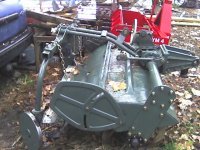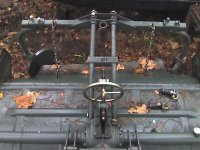3RRL said:
Hey Skunk,
Do you have any good pictures of your tiller? Looks like in the pictures of the depth draft wheels Mike posted, they are behind the tiller too? Sort of what my gauge wheels would do.
Do you have the KK Model# TG-60-Y that has those skid shoes on each side?
How much adjustment/movement are you looking for?
Rob, I have the TG 48", but same exact config. with the skids.
I had wanted to keep from adding wheels in the back, as they would roll over the freshly tilled soil, I do more landscaping and raised beds than general tilling for planting, so, leaving a pristine tilled path is desireable in my case.
That's why I was sticking with the skids.
See the picture link I posted above, Mine is set just like that one, middle bolt hole. That gives above 4" or so of tillage depth. So let's call it the Mid-point.
I'd like to get from 0" to 8" , if possible. i think the KK is rated up to 9" deep, but, I can always move the front bolt down, as I would think that gives the last little bit of depth.
Something like your wheel mechanism design could still work, just imagine it separated to each side, with a linkage to the skid, rather than a wheel.
Overall, the top of the KK tiller is not condusive for a straight forward design. Most of the design will need to focus on missing the many obstacles, (Gear box, Shaft, 3 Pt. supports) while not becoming a complicated rube-goldberg type of set-up.
I've been doodling and sketching to see what I can come up with.
I'm still liking the idea of dual cylinders, one mounted on each side from the skids up to the Top edge where there is more than enough thick angle steel to mount the cylinder clevis. The dual cynlinder design is straight forward and cuts down on a lot of fabrication steps and totally avoids the issue of obstacles on top of the tiller.
I have been beefing about the additional cost for another cylinder, but, by the time I buy the additional metal and fabricate, the extra money for the 2nd cylinder probably isn't as big a show stopper for the dual design as I originally thought.
Still pondering which direction to go.



